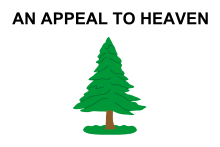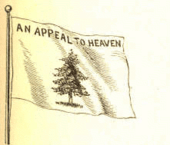Pine Tree Flag
The Tree Flag (or Appeal to Heaven Flag) was one of the flags used during the American Revolution. The flag, featuring a pine tree with the motto "An Appeal to God" or, more usually, "An Appeal to Heaven", was used originally by a squadron of six cruisers commissioned under George Washington's authority as commander in chief of the Continental Army in October 1775. It was also used by Massachusetts state navy vessels in addition to privateers sailing from Massachusetts.[1]
 A modern redrawn version of the flag | |
| Use | Other |
|---|---|
| Proportion | 2:3 |
| Adopted | October 20, 1775 |
| Design | A pine tree with the words "AN APPEAL TO HEAVEN" written in all capital letters above the tree, and a white field behind it. |
| Designed by | Joseph Reed |
Design


.png)
The design of the flag came from General Washington's secretary, Colonel Joseph Reed. In a letter dated October 20, 1775, Reed suggested a "flag with a white ground and a tree in the middle, the motto AN APPEAL TO HEAVEN" be used for the ships Washington commissioned.[2]
The following summer, on July 26, 1776, the Massachusetts General Court established the flag of the state navy with a resolution that stated in part: "...that the Colours be a white Flag, with a green Pine Tree, and an Inscription, 'Appeal to Heaven'."[2]
Pine tree symbolism
The pine tree has been symbolic in New England since the late 16th century, predating the arrival of colonists. After warring for decades, leaders of five nations — the Seneca, Cayuga, Onondaga, Oneida, and Mohawk — buried their weapons beneath a tree planted by the Iroquois Confederacy founder, the Great Peacemaker, at Onondaga. The "tree of peace" is featured in the center of the Iroquois national belt, named for the Great Peacemaker's helper, Hiawatha.[3][4]
Colonists adopted the pine as a symbol on flags and currency in the 17th century, including variants of the flag of New England and coinage produced by the Massachusetts Bay Colony from 1652 to 1682.[5] Leading up to the Revolutionary War, the pine tree became a symbol of colonial ire and resistance as well as multi-tribal support of independence..
New England's eastern white pine was prized in the colonial shipbuilding industry for its quality and height. Following their 1620 arrival to Plymouth, the Pilgrims began harvesting the indigenous pines; two decades later, they began exporting the wood as far as Madagascar.[6]
Lacking domestic production of timber, and with imports from Russia and Sweden vulnerable to disruption, England included a mast-preservation clause in the 1691 Massachusetts Charter to ensure a reliable supply of 24-inch (61 cm) diameter trees for the Royal Navy. Surveyors marked trees appropriated to the Crown with the broad arrow symbol, but the so-called broad-arrow policy was never effectively enforced and colonists cut mast pines for sale on the black market.[7]
In New Hampshire, enforcement led to the Pine Tree Riot in 1772, where a statute had been in effect since 1722 protecting 12-inch diameter trees. After being fined and refusing to pay for possessing trees marked with the broad arrow, a New Hampshire mill owner leading other mill owners and townsmen assaulted the sheriff and his deputy sent to arrest him by giving him one lash with a tree switch for every tree which the mill owners were fined, cutting the ears, manes, and tails off their horses, and forced them out of town through a jeering crowd. This was one of the first acts of forceful protest against British policies. It occurred almost two years prior to the more well-known Boston Tea Party protest and three years before open hostilities began at the Battles of Lexington and Concord.[8]
Months prior to Colonel Joseph Reed's suggestion for using the pine, the pine was used on the flag that the colonists flew at the Battle of Bunker Hill in June 1775. The historically accepted flag has a red field with the green pine tree in the upper left corner as depicted in John Trumbull's The Death of General Warren at the Battle of Bunker's Hill, June 17, 1775 painting. Provided Reed was aware of the Bunker Hill flag, there was a precedent to incorporate the pine in another Colonial martial flag.
Given the pine tree's significance to the colonists and since the flag was to fly over colonial warships, the pine offered an appropriate and ironic symbol, as it flew atop the very structure for which the British had sought to harvest the white pine.
The flag of Maine, the "pine tree state", featured a pine tree on a buff field with a blue star in the canton from 1901 to 1909.
"Appeal To Heaven"
The phrase is a particular expression of the right of revolution used by British philosopher John Locke in Second Treatise on Civil Government which was published in 1690 as part of Two Treatises of Government refuting the theory of the divine right of kings.[9]
Locke's works were well-known and frequently quoted by colonial leaders, being the most quoted authority on the government in the 1760-1776 period prior to American independence. Thomas Jefferson was accused of plagiarizing Locke in certain sections of the Declaration of Independence by fellow Virginian delegate Richard Henry Lee.[10]
Prior to Colonel Reed's suggestion and Massachusetts General Court establishing the Pine Tree flag as the standard of the Massachusetts navy, "an appeal to Heaven" or similar expressions had been invoked by the Massachusetts Provincial Congress in several resolutions, Patrick Henry in his Liberty or Death speech, and the Second Continental Congress in the Declaration of the Causes and Necessity of Taking Up Arms. Subsequently, it was used again by the Second Continental Congress in the Declaration of Independence.
In popular culture
- The Pine Tree flag is shown in the opening credits of all seven episodes of the 2008 HBO miniseries John Adams and is shown being carried by colonial forces in "Part I: Join or Die".
- The Pine Tree flag appears with several other Revolutionary War flags on the desk of Ron Swanson, a character on the NBC sitcom Parks and Recreation.
See also
- Flag of New England
- 1901 Maine Flag
- American Enlightenment
- Thompson's War
- Pine Tree Riot
References
- Naval History Center FAQ. Retrieved from http://www.history.navy.mil/faqs/faq122-1.htm Archived 2012-10-04 at the Library of Congress Web Archives.
- Wyatt, Rick (2002). Washington's Cruisers Flag (U.S.). Retrieved from http://www.crwflags.com/fotw/flags/us-wacr.html.
- "Hiawatha Belt". Onondaga Nation. Onondaga Nation. Retrieved 12 July 2020.
- "The 6 Nations of the Iroquois Confederacy". Britannica. Britannica. Retrieved 12 July 2020.
- "Massachusetts Pine Tree Shilling, "1652"". Legendary Coins & Currency. Smithsonian National Museum of American History. Archived from the original on 7 November 2016. Retrieved 12 July 2020.
- "Why The Name King's Mark?". King's Mark Resource Conservation & Development Project, Inc. King's Mark Resource Conservation and Development Council. 24 February 2011. Retrieved 12 July 2020.
- "Why The Name King's Mark?". King's Mark Resource Conservation & Development Project, Inc. King's Mark Resource Conservation and Development Council. 24 February 2011. Retrieved 12 July 2020.
- "Weare, NH 1772: Rebellion Before the Revolution–The Pine Tree Riot". 21 March 2006.
- John Locke. "Second Treatise on Civil Government". - Chapter 3 Sect. 20-21 & Chapter 14 Sect. 168
- "John Locke – A Philosophical Founder of America". 29 December 2016.
External links
![]()